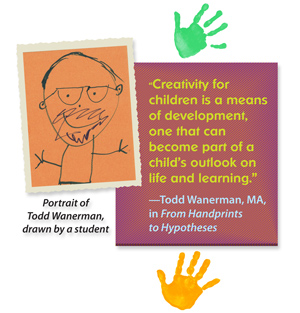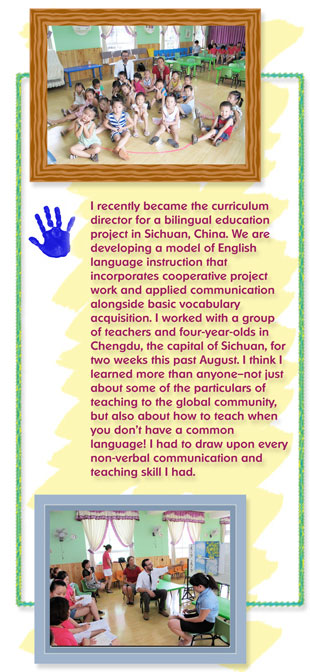Todd Wanerman
Published: 2012
When Todd Wanerman, MA, isn’t dreaming up new projects for his classroom of toddlers and two-year-olds, he’s leading workshops and community partnerships with parents, presenting at national conferences, lecturing at San Francisco State University, or brushing up on his French. Read on to learn how a keynote lecture led to a lingering question and, eventually, his new book, From Handprints to Hypotheses.
Your new book, From Handprints to Hypotheses (available in December), blends inspiration and how-to information to bring the Project Approach into the toddler and two-year-old classroom. Where did your idea come from?
My first exposure to the Project Approach came at the 1997 NAEYC Conference in Anaheim, when I heard Sylvia Chard’s keynote lecture. I remember another participant asking a question that I had been wondering, too: How do you adapt project work for infants and toddlers? At the time, Sylvia talked about toddlers observing from the sidelines and then working their way into project work when they were older. I went back to my toddler classroom wondering, but what now? I read The Project Approach and started experimenting with elements that might work for very young children.
Eleven years later at the NAEYC Conference in Washington, I noticed that Sylvia and Yvonne Kogan were presenting a workshop on adapting the Project Approach with toddlers. They presented a series of ideas about helping very young children discover representation and the seeds of inquiry. I spoke with Sylvia afterward and told her about how her comments in 1997 had started an inquiry process for me, and we both remarked upon how much more we all seemed to be thinking about inquiry and toddlers. I left thinking, there should be a book about this.
I was surprised that Sylvia and Yvonne weren’t rushing a book to press, and so I started thinking about what I could say on the subject. I realized that there were some elements of project work—planning, negotiating and revisiting; observation-based inquiry; sequential evolving use of materials—that I had been using in certain art projects. I also knew up front that I wanted to write a very enjoyable, hands-on book that would make this type of pedagogy appealing and manageable for any kind of early childhood educator.
I decided to focus on art and organize a book around actual step-by-step projects that anyone could do. But I also wanted to wrap the nuts and bolts material in a streamlined overview of this fascinating age and developmental stage. And that’s how the book turned out—equal parts inspiration and information; a very visually-oriented book about visual arts; and a breezy read that captures the effect and relationships that drive learning as much as it defines toddler development or pedagogy. 
Can you share an example of what the Project Approach look like in a toddler and twos classroom?
The quintessential project from the book takes up all of chapter four, and it is also the project that helped me think through many of the basic perspectives in the book: a year-long engagement with one large canvas from the art store. We set up the canvas in our art area each Monday and offered different tools and hues. The idea is to start with very large tools and monochromatic tones, and then move on to smaller tools and turn over some of the color choosing and mixing to the children. The project begins as an open-ended, sensory-motor exploration and ends up almost a year later as negotiated, co-constructed, evolving representational work. The structure is very open—the children can do whatever they want each time. But the changes in basic materials, along with their natural maturation, creates ongoing project work that inspires the children to revisit past work and plan for future sessions.
After more than twenty-five years as an early childhood professional, you know a thing or two about the most effective ways to teach toddlers. What is the best advice you have for educators and caregivers who are new to the field or age group?
Even as we try to help toddlers access their symbolic and abstract thinking—to step up to collaboration, negotiation and planning—we must always remember that these very young children learn through effect, regulation, and relationships. A teacher’s curiosity, wonder, affection, confidence, and the overall dispositions she brings to the classroom are the core of her teaching. Infants and toddlers learn from the ways we interact with ourselves, other adults, and, of course, them. Children and families respond to teachers who truly like, appreciate, and support them, and pay honest, receptive attention to what children and families bring to a classroom community. In this way, toddlers are ripe for the Project Approach’s objective of teaching learning habits and dispositions. But we toddler teachers have to love to learn!
How did you decide which projects to put into From Handprints to Hypotheses? Do any of the projects tie into personal favorite teaching moments?
Choosing the projects to include in the book brought me back to many special moments and projects. Each group of children is unique, just like individual children. So I re-discovered some projects, like the Rain Painting or The Batman Project, that had only happened a certain way with one group in the past. This led me to revisit many special moments with children who have long since gone on to elementary school, and to reconnect with their families. It also inspired me to revisit some ideas that had evolved or trailed off and to bring them back into the curriculum.
I wanted to include lots of pictures in the book—I wanted the children to do a lot of the teaching and I wanted to show readers the projects as they evolved. This gave me the opportunity to ask families I have worked with over the last ten years to become collaborators on the project by agreeing to include their children’s images. I was so inspired by their responses. Each and every family expressed more excitement and commitment to the project than I could have dreamed. That positive response and collaboration—and the impact it had on the quality of this book—was one of the most special teaching experiences I have ever had.

In addition to writing books and teaching toddlers, what else should we know about you?
I lived in Paris for a while and used to speak fluent French. I am going to be giving a keynote address at the Focus on Inclusion conference in New Brunswick, Canada, this February. The conference will be presented in English and French. I’m trying to decide if I want to do some of my own translating!
Learn more and see a full list of titles by Todd Wanerman.